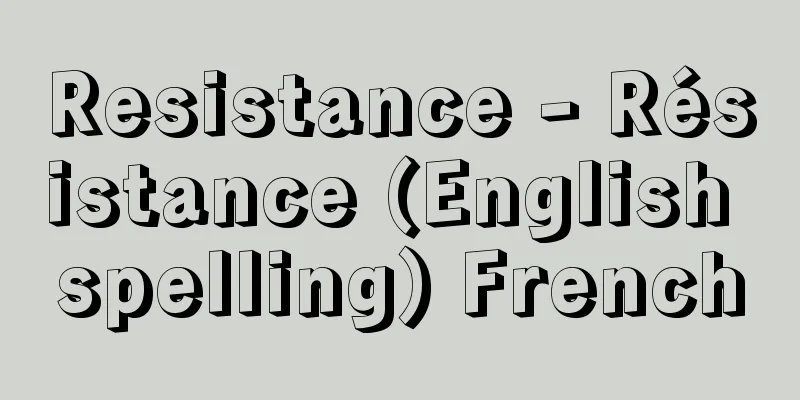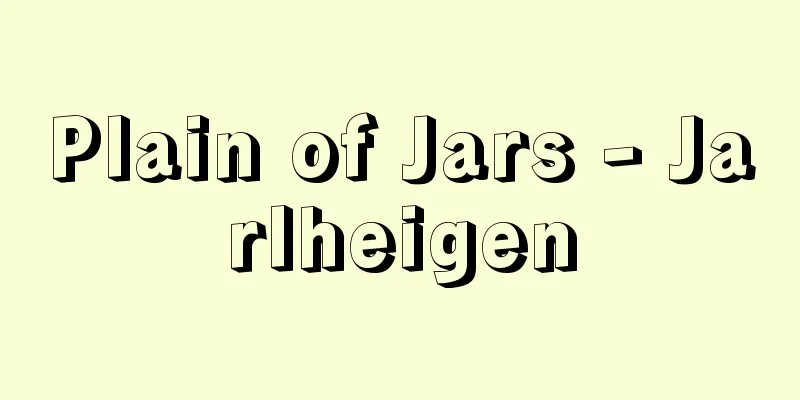Resistance - Résistance (English spelling) French

|
Resistance is a French word meaning resistance. Here, it refers to the resistance movement in countries occupied by the Axis powers during World War II. It occurred in various places, but especially in France, not only did organizations calling themselves "resistance" appear early on, but the movement showed various developments and played a major role in the liberation of France. Also, under the occupation, works such as poems and novels that would later be called resistance literature were produced, and influenced ideological trends after the war. Thus, the French word "resistance" came to be used broadly to refer to resistance movements in various countries. In fact, the fact that such resistance movements developed in various places was a distinctive feature of World War II, and had a significant impact on the progress of the war and the state of postwar politics in various countries. Incidentally, the movements against the power of Hitler and Mussolini in Germany and Italy were against the systems of their own countries, so we will exclude them here for the time being, and the movement against Japanese occupation of Asian territories will be considered as a separate issue and limited to Europe. [Haruyasu Kato] Western EuropeAs the German army advanced from April to June 1940, the defeated countries were occupied by the German army or were under the control of fascist governments that cooperated with the German army, except for Denmark, where the king and his government continued to exist until 1943 and the pre-war governing system was relatively well preserved. In Norway, the king fled to England, and the pro-Nazi Quivisling took power. In the Netherlands, the queen and her government fled to London, and the German army pushed Anton Adriaan Mussert (1894-1946) of the Dutch National Socialist Party, who eventually became the national leader (Hüller) in 1942. In Belgium, King Leopold III remained in the country, but he considered himself a "prisoner of war" of the German army and refused to cooperate with it, and Prime Minister Pierlot and other cabinet members fled to London and cooperated with the British army with their military forces. Thus, from the early stages of the war, London was the location of the governments in exile of the defeated countries. The British not only provided protection for the government in exile, but also cooperated with it by establishing a new branch of the Special Operations Office (SOE) under the Ministry of Economic Warfare, in order to utilize the secret connections that the government in exile had with supporters in the UK for intelligence activities and even sabotage. These activities would become an important part of the resistance movement. The armistice (June 22, 1940) concluded with the surrender divided France into a large part of the country, north and south, with the north under direct occupation by the German army, and the south under Marshal Pétain's government in Vichy, establishing the so-called Vichy regime. However, General de Gaulle, who fled to London on June 18, began calling for the government not to accept France's surrender through BBC broadcasts from the evening of that day, and soon organized the "Free French Forces" in London to continue the resistance. In the cases of the countries mentioned above, the legitimate governments at the time of the defeat continued to exist in London, and the people were faced with the choice of supporting them or submitting to the German army and the powers that followed them. However, in the case of France, de Gaulle, who called for resistance in London, was merely a "deserter" who ignored the decisions of the government and the army, and many French people did not even know his name. This point is a major characteristic of the development of the French Resistance. In the north of France, the resistance movement was a spontaneous and direct underground movement by relatively small groups, which hid weapons, sabotaged the occupying administration, escaped and established communication routes across the border between North and South, and published anti-occupation leaflets and pamphlets. In the midst of this movement, a group of young intellectuals centered around the Museum of Anthropology in Paris published a newspaper called "Resistant," the first issue of which was published on December 15, 1940, which is noteworthy as showing that this word had become a conscious expression of people's activities. On the other hand, the south was under the control of the Vichy government, and the first task was to oppose that system and the fascist trend that was gathering there. Therefore, relatively large groups were organized here, including socialist and labor activists, Christian democrats, etc., and their activities were more political or ideological in nature than the movement in the north, which progressed to constant confrontation with the occupying forces. It was after November 1942 that the southern part of the country came under direct occupation by the German army, and the nature of the movement changed significantly. Furthermore, after the outbreak of the German-Soviet War in June 1941, the Communist Party clearly moved towards resistance against Germany, and began activities that included armed action. This had important significance not only for France, but also for resistance movements in other countries. After the German army completely occupied both the north and south of France at the end of 1942, the movement rapidly expanded in various ways. First, many of the military personnel who had been under the Vichy government joined the resistance movement, and second, many young people refused to be conscripted into compulsory labor (STO) by the German army and fled to mountainous areas to form the Maquis. The activities of these young people not only expanded the base of the resistance, but also brought a spontaneous and dynamic force to the movement. De Gaulle, who was abroad, considered the support of the domestic Resistance essential to gain recognition from the Allies, and worked to unify the various movements. Jean Moulin (1899-1943) was the man who worked to achieve this goal. He infiltrated France at the end of 1941, and through his efforts, the southern organizations were united into the United Resistance Movement (MUR), and cooperation with the northern movements also progressed, and on May 27, 1943, a secret meeting was held in Paris to found the National Council of the Resistance (CNR). In this way, de Gaulle established his authority as a leader of the liberation of the French people. However, the desire to achieve one's own liberation by one's own hands, which arose within the Resistance, often led to conflicts between the domestic Resistance movements and de Gaulle, and also within the movements themselves, over the form of the movement. The Paris uprising in August 1944 was made all the more dramatic by this struggle for leadership in the liberation movement. Spontaneous resistance movements that went beyond the framework of the war waged by the Allied powers or the exiled governments appeared to a greater or lesser extent in the countries mentioned above. In France, as well as in these countries, the movements were not simply about liberation from the German army, but also included criticism of the prewar system that had led the country to defeat, and a desire for a new politics and society through liberation, which became a major issue in postwar politics. This was particularly evident in Italy. After Mussolini was overthrown in July 1943, Italy was divided into the south under the Badoglio government, which surrendered to the Allied forces (announced on September 8), and the north, where German troops entered and Mussolini was re-established. In the north, a resistance movement that took on the appearance of a fierce partisan war developed. The resistance movements did not join Badoglio, who was connected to the fascist regime, or the restoration of royal power, but formed the National Liberation Committee (CLN), gradually liberated the north on their own, and demonstrated their intention to establish a provisional government under the committee. A compromise was reached in April 1944 between the King and Badoglio government, which was recognized by the Allies, and the Liberation Committee, due in particular to a change in policy by the Communist Party (known as the Salerno Turn), but conflicts between the resistance fighting in the north and the central government continued, leading to the focus of postwar politics over whether the monarchy should continue and the direction of postwar reforms. The liberation of Italy reached its final stage with the Milan uprising in April 1945, but when Mussolini was captured by partisans, the Northern Liberation Committee chose to execute him themselves rather than hand him over to the Allied forces. [Haruyasu Kato] Eastern EuropeIt is known that the racial policy of Nazi Germany targeted Jews and Roma as the targets of blatant segregation and exclusion, but in the eastern part of Europe, as was especially the case in Poland, non-Germanic peoples were positioned as inferior races that should serve the "Aryans," and while they were mobilized as soldiers and laborers, harsh policies were adopted to break them up politically and culturally as a people. Therefore, in Eastern Europe, the resistance movement appeared as an armed struggle that was generally more severe than in Western Europe. In the case of (then) Yugoslavia, an underground organization called Chetniks was created by Mihailovic among the military officers, and he was appointed as the supreme commander by the royal government in exile in London. However, apart from Mihailovic, who blatantly prioritized Serbs in the multi-ethnic state of Yugoslavia and tried to preserve the old power, a unique resistance movement was organized around Tito of the Yugoslav Communist Party, and the most active partisan struggle was developed among the resistances in various countries. This struggle achieved the self-liberation of almost the entire country, and Tito became the leader of the new liberation government. Mikhailovich was willing to secretly cooperate with the Axis powers in order to oppose the partisans, and he lost the trust of London and fell into disgrace. Meanwhile, Tito did not submit to pressure from the Soviet Union to bring the Yugoslav Communist Party under its control, and after the war he occupied a unique position in the Soviet Union's drive to socialize Eastern Europe. The case of Poland was one in which the resistance movement took a tragic turn. There, with the support of the London government in exile, resistance organizations were formed early on, and in 1944 the Council of National Unity was formed with representatives of all parties except the Communist Party. In August of that year, in response to the advance of the Soviet army, a general uprising was launched, including the city's Communist Party members, with the aim of liberating Warsaw on its own. However, this uprising was annihilated by the German army, which reduced Warsaw to ruins after about two months of fierce urban fighting, without the aid of the Soviet army that was imminent. In the end, Poland was liberated from the outside by the Soviet army, and after the war the Liberation Committee (commonly known as the Lublin Committee), which was organized in Moscow with the Communist Party in exile at its core, took over as the bearer of postwar power. In the case of (then) Czechoslovakia, internal conflict within the resistance did not come to the surface very much, due in part to cooperation between the London government in exile (President Beneš) and the Soviet Union, and armed struggle itself only emerged in limited situations towards the end of the war, but in Greece, Britain intervened in the internal resistance conflict over the formation of post-war power, which sparked a civil war between Communist factions and Royalist government factions after liberation. Thus, in Eastern Europe too, people's desire for self-liberation and new social reforms within the resistance movement was stronger than in Western Europe, since it was a region that had long been under the subjugation of other countries, but this raised major questions about the state power that guided the people, or the nature of political organizations, and particularly about the process of socialization led by the Soviet Union after the war. Furthermore, the partisan struggle in German-occupied areas of the Soviet Union cannot be ignored as part of the Soviet war effort. There were also Jewish resistance movements in various countries. Furthermore, there were resistance movements in colonies, such as that seen in Ethiopia under Italian rule, which should be noted in relation to post-war nationalist movements. [Haruyasu Kato] "De Gaulle, Memoirs of the Great War, vol. 1-6" (1960-66, Misuzu Shobo) translated by Murakami Mitsuhiko et al. "Resistance - A History of the Anti-German Resistance of French Citizens in World War II" (1970, Shinjinbutsu Oraisha) by Tan Tokusaburo "Anti-German Resistance Movements in Europe" (included in "Iwanami Lecture Series on World History 29" 1971, Iwanami Shoten) " "Umihara Takashi, ed. "Documents of Contemporary History 8: Resistance" (1973, Heibonsha)" "Kitahara Atsushi, "The Italian Resistance" (included in "State and Society in the Age of Fascism 8: Movement and Resistance, Vol. 2" edited by the Institute of Social Science, University of Tokyo, 1980, University of Tokyo Press)" "E. Dastier, translated by Inoue Takahiro "Paris is Liberated" ("Documentary French History" 1986, Hakusuisha)" "History of the Resistance" by H. Michel, translated by Tan Tokusaburo (Hakusuisha, Que sais-je) " ▽ "Underground Resistance Movement: 1938-1945" by H. Michel, translated by Kirio Kazuo (Hakusuisha, Que sais-je)" [References] | | | | | | | |Source: Shogakukan Encyclopedia Nipponica About Encyclopedia Nipponica Information | Legend |
|
抵抗を意味するフランス語。ここでは、第二次世界大戦において枢軸国の占領下に置かれた諸国における抵抗運動をさす。それは各地に起こったが、とくにフランスでは、早くから「レジスタンス」を名のる組織が現れただけでなく、運動は多様な展開を示し、フランスの解放に大きな役割を果たした。また占領下において、のちにレジスタンス文学とよばれるようになる詩や小説などの作品が生み出され、戦後の思想動向にも影響を与えた。こうして、レジスタンスというフランス語は、諸国の抵抗運動を広くさすことばとして用いられるようになった。事実、このような抵抗運動が各地で展開されたことは、第二次大戦の際だった特徴をなしており、戦争の推移や、諸国の戦後政治のあり方にも、重大な意味をもった。なお、ドイツやイタリアでのヒトラーやムッソリーニの権力に抵抗する運動は、それぞれ自国の体制に対するものであるから、いちおうここでは除外して考え、また、アジアにおける日本の占領地支配に抗した運動は別の局面の問題として、ヨーロッパ方面に限定してみることにする。 [加藤晴康] 西ヨーロッパ1940年4~6月、ドイツ軍の進出とともに、敗北した諸国では、国王とその政府が曲がりなりにも43年まで存続し戦前の統治機構が比較的温存されたデンマークを除いて、ドイツ軍の占領ないしはそれに協力するファッショ的政権の支配下に置かれた。ノルウェーでは国王がイギリスに亡命して、親ナチスのクビスリングが権力を握り、オランダもまた女王とその政府はロンドンに亡命、ドイツ軍は、オランダ国家社会主義党のムッセルトAnton Adriaan Mussert(1894―1946)を押し立て、彼はやがて42年に国家指導者(ヒューラー)を名のる。ベルギーでは、国王レオポルド3世は国内にとどまったが、自らをドイツ軍の「捕虜」とみなしてそれへの協力を拒否、ピエルロ首相以下の閣僚がロンドンに逃れて、保持する軍事力をイギリス軍と協力させた。このように、戦争初期からロンドンには敗れた諸国の亡命政権が集中した。イギリスはこれを保護するだけでなく、亡命政権が本国の支持勢力との間に有するひそかなつながりなどを情報活動やさらには破壊工作などに活用すべく、経済戦争省の下に新たに特殊作戦部(SOE)を設置して協力させた。これらの活動は、抵抗運動の重要な一環を構成することとなる。 フランスは、降伏とともに結ばれた休戦条約(1940年6月22日)により、国土が大きく南北に分割され、北部はドイツ軍の直接占領下に置かれ、南部はペタン元帥がビシーに政府を置き、いわゆるビシー体制を敷いた。しかしこれに対し、6月18日にロンドンに逃れたドゴール将軍が、その日の夕方よりBBC放送を通じてフランスの降伏を認めないよう訴え始めていて、まもなくロンドンで「自由フランス軍」を組織して抗戦継続を目ざした。先に述べた諸国の場合、敗戦当時の合法政権がロンドンに存続して、国民はこれを支持するか、あるいはドイツ軍やこれに追随する権力に従うか、という選択の前にたった。しかし、フランスの場合はそれと異なり、ロンドンで抗戦を訴えたドゴールは、政府と軍の決定を無視した一介の「脱走軍人」にすぎず、多くのフランス人はドゴールの名さえ知らなかったという。この点はフランス・レジスタンスの展開に大きな特徴を与えている。 フランス国内での抵抗運動は、北部では、占領初期から武器の隠匿、占領行政へのサボタージュ、南北の境界や国境を越えての脱走や連絡ルートの形成、反占領軍ビラやパンフレットの発行など、比較的小グループによる自発的で直接的な地下活動が生み出されていった。そうした動きのなかで、パリの人類博物館を中心にする若い知識人グループが、1940年12月15日を第1号とする『レジスタンス』と題する新聞を発行したことは、このことばが人々の活動の自覚的表現となったことを示すものとして注目される。他方、南部はビシー政府の下にあり、その体制、あるいは、そこに結集するファシズム的潮流に反対することが、まず第一の課題となった。したがってここでは、社会主義や労働運動の活動家、キリスト教民主主義者などによる比較的大きなグループが組織され、その活動も、占領軍との絶えざる対決に進んだ北部の運動よりは、政治的ないし思想的な運動という性格が強かった。南部がドイツ軍の直接占領下に置かれ、運動の性格も大きく変わったのは、42年11月以降のことである。なお、41年6月の独ソ戦開始以後、共産党が明確に対独抵抗へと進み、武装行動を含む活動に入ったことは、フランスばかりではなく、諸国の抵抗運動にとって重要な意味をもった。 1942年末のドイツ軍による南北全面占領ののち、運動は急速に多様な広がりを示すようになった。一つは、これまでビシー政府の下にあった軍人たちの多くが抵抗運動に入ったこと、いま一つは、ドイツ軍による義務労働徴用(STO)を拒んで、若者たちが数多く山岳地帯などに逃れてマキを形成したことである。これら若者の活動は、レジスタンスの底辺を拡大するとともに、一面では、自発的でダイナミックな力を運動にもたらした。 国外にあったドゴールは、連合国に自己の地位を認めさせるためにも、国内レジスタンスの支持を不可欠とし、諸運動の統合に努めた。そのために活動したのがジャン・ムーランJean Moulin(1899―1943)であり、1941年末より国内に潜入した彼の努力により、まず南部諸組織がレジスタンス統一運動(MUR)に結集、北部諸運動の連携もしだいに進んで、43年5月27日、パリでひそかにレジスタンス全国評議会(CNR)の結成会議が開かれた。こうして、ドゴールはフランス国民の解放の指導者としての権威を確立していった。しかし、レジスタンス内部で生まれた、自らの解放は自らの手で、という志向は、国内レジスタンスの諸運動とドゴールとの間に、また諸運動内部でも、運動のあり方をめぐってしばしば対立を生んだ。44年8月のパリ蜂起(ほうき)は、一面ではこのような解放に向かっての主導権争いによっていっそう劇的なものとなっている。 連合国あるいは亡命政権による戦争遂行の枠を超えた自発的な抵抗の動きは、先にあげた諸国でも多かれ少なかれ現れている。フランスはもちろん、それらの国でもその動きは、単にドイツ軍からの解放というだけでなく、国を敗北に導いた戦前の体制への批判、解放による新しい政治・社会への願望をはらむものとなり、そのことは戦後政治の大きな争点となった。イタリアではとくにそれが強く現れている。イタリアは1943年7月ムッソリーニが失脚してのち、連合軍に降伏(9月8日公表)したバドリオ政権の下の南部と、ドイツ軍が進駐してムッソリーニを再度押し立てた北部に分かれたが、この北部で、激しいパルチザン戦の様相を呈したレジスタンスが展開された。レジスタンス諸運動は、ファシズム体制につながっていたバドリオ、あるいは国王権力の復活に同ぜず、国民解放委員会(CLN)を結成して、北部をしだいに自力解放するとともに、同委員会による臨時政府樹立の意志を示した。連合国が承認した国王・バドリオ政権と解放委員会の間では、とくに共産党の方針転換により44年4月に妥協が成立(サレルノ転回とよばれる)するが、なお北部で戦うレジスタンスと中央政府との葛藤(かっとう)は絶えず、王政存続の是非、戦後改革の方向をめぐる戦後政治の焦点に連なった。イタリアの解放は、45年4月ミラノの一斉蜂起により最終局面を迎えるが、パルチザンに捕らえられたムッソリーニを、北部解放委員会は連合軍に引き渡すより自ら処刑することを選んだのであった。 [加藤晴康] 東ヨーロッパナチス・ドイツの人種政策が、ユダヤ人やロマなどを露骨な隔離・排除政策の対象としたことは知られているが、ヨーロッパの東側では、とくにポーランドに現れたように、非ゲルマン系民族を「アーリア人」に奉仕すべき劣等民族として位置づけ、兵力・労働力として動員する一方、政治的にも文化的にも民族としては解体する厳しい政策がとられた。したがって、東ヨーロッパでは抵抗運動は、西ヨーロッパよりも全体的にみて苛烈(かれつ)な武装闘争として現れた。ユーゴスラビア(当時)の場合、軍隊の士官将校のなかからミハイロビチによりチェトニクとよぶ地下組織がつくられ、彼はロンドンに亡命した国王政府により最高司令官に任じられた。しかし、多民族国家ユーゴスラビアで露骨にセルビア人優先を打ち出し、旧権力温存を図るミハイロビチとは別に、ユーゴ共産党のチトーを中心に独自の抵抗運動が組織され、諸国レジスタンスのなかではもっとも活発なパルチザン闘争が展開された。この闘争は、ほとんど全土の自力解放を成し遂げ、チトーは新しい解放政権の指導者となった。ミハイロビチは、このパルチザンと敵対するため、枢軸側とひそかに協力することも辞せず、ロンドンの信用をも失って失墜した。一方、チトーは、ユーゴ共産党を自己の統制下に置こうとするソ連の圧力にも従わず、戦後、ソ連による東ヨーロッパの社会主義化の動きのなかで独自の地位を占めた。 抵抗運動が悲劇的な展開をみせたのはポーランドの場合であった。ここではロンドン亡命政府の支持の下に、早くから抵抗組織が生まれ、1944年には共産党を除く諸党代表による国民統一評議会が組織された。同年8月、ソ連軍の進撃に呼応しつつ、ワルシャワの自力解放を目ざして、同市の共産党系の人々をも含めた一斉蜂起が起こされたが、この蜂起は、目前に迫ったソ連軍の援助も得られないままに、約2か月間の激しい市街戦ののち、ワルシャワをほぼ廃墟(はいきょ)と化したドイツ軍の攻撃によって壊滅した。結局ポーランドは、ソ連軍によって外から解放され、戦後権力の担い手は、モスクワで亡命共産党員らを軸に組織された解放委員会(通称ルブリン委員会)がその任についた。 チェコスロバキア(当時)の場合は、ロンドン亡命政府(ベネシュ大統領)とソ連との協調もあり、武装闘争自体が戦争末期の限られた局面で現れたこともあって、レジスタンスの内部抗争はそれほど表面に現れなかったが、ギリシアでは、国内レジスタンスの抗争に、戦後権力形成をめぐってイギリスが介入し、解放後、共産党系と国王政府系との内戦を引き起こした。こうして、東ヨーロッパでも、抵抗運動のなかで人々の自らの解放と新たな社会改革への志向は、むしろ、長く他国の従属下にあった地域だけに西ヨーロッパよりは強く現れたといえるけれども、それだけに、人々を指導する国家権力、あるいは政治組織のあり方、とりわけ戦後のソ連が主導した社会主義化の過程に、大きな問題を投げかけるものとなったのである。 なお、ソ連内のドイツ軍占領地域でのパルチザン闘争は、ソ連の戦争遂行の一環として無視できないし、また、諸国のユダヤ人の抵抗運動もあり、さらに、植民地でも、イタリア支配下のエチオピアにみられたような抵抗運動が存在したことは、戦後の民族運動などとの関連で注意すべきことであろう。 [加藤晴康] 『ドゴール著、村上光彦他訳『ドゴール大戦回顧録1~6』(1960~66・みすず書房)』▽『淡徳三郎著『レジスタンス――第二次大戦におけるフランス市民の対独抵抗史』(1970・新人物往来社)』▽『加藤晴康・木戸蓊『ヨーロッパにおける対独抵抗運動』(『岩波講座 世界歴史29』所収・1971・岩波書店)』▽『海原峻編『ドキュメント現代史8 レジスタンス』(1973・平凡社)』▽『北原敦『イタリアのレジスタンス』(東京大学社会科学研究所編『ファシズム期の国家と社会8 運動と抵抗 下』所収・1980・東京大学出版会)』▽『E・ダスティエ著、井上堯裕訳『パリは解放された』(『ドキュメンタリー・フランス史』1986・白水社)』▽『H・ミシェル著、淡徳三郎訳『レジスタンスの歴史』(白水社・文庫クセジュ)』▽『H・ミシェル著、霧生和夫訳『地下抵抗運動――1938-1945』(白水社・文庫クセジュ)』 [参照項目] | | | | | | | |出典 小学館 日本大百科全書(ニッポニカ)日本大百科全書(ニッポニカ)について 情報 | 凡例 |
<<: Resistance literature (English: littérature de la résistance)
>>: Regis - Jean Baptiste Régis
Recommend
Staple food - shushoku
〘 noun 〙 The food that is the center of daily meal...
Amat y Junyent, M.de (English spelling) AmatyJunyentMde
…Following reports of the tyranny and corruption ...
Tobruk (English spelling)
A port city in the Cyrenaica region in northeaster...
Inagaki Taruho - Inagaki Taruho
Novelist. Born in Osaka. Interested in airplanes,...
antiquarian bookshop (English)
...the general term for businesses that buy and s...
Chrysanthemum flower - Chrysanthemum flower
...Some species transmit plant pathogens such as ...
Roichi Naito
Freedom and civil rights activist and politician....
wayang kritik (English spelling)
…Today, only one dalang remains in East Java, and...
Coliidae
…General term for birds of the family Coliidae, o...
Gros-Guillaume (English spelling)
...The latter produced Pierre de Larivey's (c...
Lockheed Scandal - Lockheed Scandal
The largest corruption case since World War II, i...
The Playground Training Picture Book - Shibakinmouzui
A commentary on Kabuki. Written by Shikitei Sanba....
East City and West City - East City and West City
Official markets were established in the ancient c...
Canadian Whisky
...Barrel ageing is at least three years; previou...
Identification - Observation
A tag issued to publicly certify that permission h...









